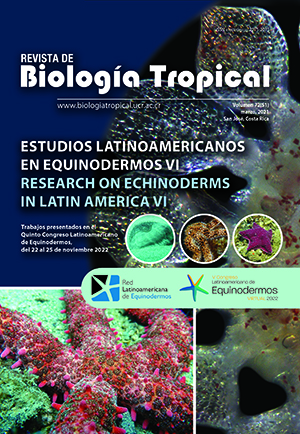Abstract
Introduction: Irregular echinoids are characterized by having a selection of the substrate mainly on soft bottoms. In El Salvador, seven species of irregular echinoids have been recorded on the main sandy beaches of the country, M. stokesii is one of them.
Objective: Determine the abundance, density and size structure of M. stokesii on beaches at the mouth of the El Tamarindo estuary, El Salvador.
Methods: The research was carried out in the dry season in the east of the country on the beaches of the El Tamarindo estuary, which is characterized by large extensions of sand mixed with organic matter. At each site, band transects parallel to the coast were plotted by 9 quadrants of 10 m2 separated from each other by 10 m (total area of 90 m2), where individuals of M. stokesii found within the delimited area were counted and measured.
Results: 958 individuals of M. stokesii were counted with a total density of 10.64 ± 13.22 ind/m2. The size range was 1–6.5 cm. The habitat was characterized by presenting sand with organic matter in the first mm of the substrate in the company of other invertebrates.
Conclusions: The abundance and density of M. stokesii are similar to the ones recorded in other studies in the region.
References
Barraza, J. E. (2017). La sensibilidad ambiental de los ecosistemas costeros de El Salvador ante derrames de hidrocarburos (1a ed.). Instituto de Ciencia, Tecnología e Innovación.
Barraza, J. E., & Hasbún, C. R. (2005). Los equinodermos (Echinodermata) de El Salvador. Revista de Biología Tropical, 53(S3), 139–146. https://doi.org/10.15517/rbt.v53i3.26772
Brusca, R. C., & Brusca, G. J. (2005). Invertebrates (2a ed.). McGraw Hill.
Dexter, D. M. (1977). A natural history of the sand dollar Encope stokesi L.Agassiz in Panama. Bulletin of Marine Science, 27(3), 544–551.
Domínguez, J. P., Castillo, J., & Magaña, R. (2018). Inventario nacional de humedales [Informe técnico]. Ministerio de Medio Ambiente y Recursos Naturales.
Galindo-Anaya, A., Nisperuza-Pérez, C., & Quirós-Rodríguez, J. A. (2020). Aspectos poblacionales de Encope michelini (Clypeasteroida: Mellitidae) y asociación con el pinotérido Dissodactylus crinitichelis en el sector La Ahumadera, bahía Cispatá, Caribe colombiano. Revista Mexicana de Biodiversidad, 91, e913456. https://doi.org/10.22201/ib.20078706e.2020.91.3456
Ghiold, J. (1988). Species distributions of irregular echinoids. Biological Oceanography, 6, 79–162. https://doi.org/10.1080/01965581.1988.10749524
Krebs, C. J. (1999). Ecological Methodology (2a ed.). Addison Wesley Longman.
Ministerio de Medio Ambiente y Recursos Naturales (MARN). (2022). Caracterización biológica del humedal costero estero El Tamarindo y áreas marinas de influencia, municipio de Conchagua, La Unión. San Salvador: MARN. 128 p.
Morín, J. G., Kastendiek, J. E., Harrington, A., & Davis, N. (1985). Organization and patterns of interactions in a subtidal sand community on an exposed coast. Marine Ecology Progress Series, 27, 163–185.
Ramos, F., & Segovia, J. (2021). Los equinodermos de El Salvador depositados en colecciones científicas. Revista de Biología Tropical, 69(S1), 254–264. https://doi. org/10.15517/rbt.v69iSuppl.1.46357
Universidad de San Carlos de Guatemala. (2011). Manual de Estadística Descriptiva [Manual]. Facultad de Ingeniería, Universidad de San Carlos de Guatemala.
Vargas, J., & Solano, S. (2011). On Melitella stokessi and Amphipholis geminata (Echinoderamata), from an intertidal flat in the upper Gulf of Nicoya estuary, Pacific, Costa Rica. Revista de Biología Tropical, 59(1), 193–198. https://doi.org/10.15517/rbt.v59i1.3189
##plugins.facebook.comentarios##

This work is licensed under a Creative Commons Attribution 4.0 International License.







